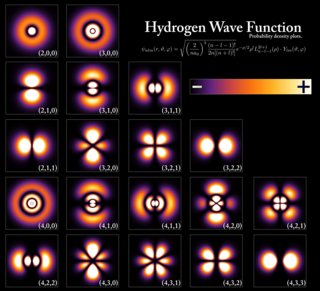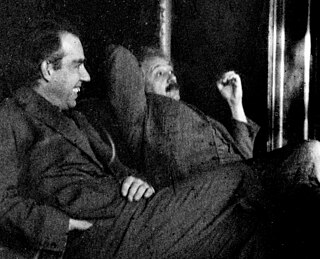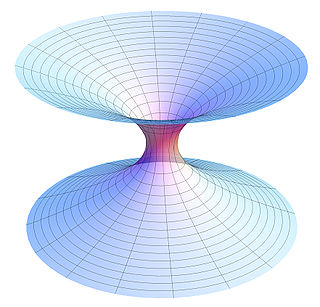Related Research Articles

Albert Einstein was a German-born theoretical physicist who is widely held as one of the most influential scientists. Best known for developing the theory of relativity, Einstein also made important contributions to quantum mechanics. His mass–energy equivalence formula E = mc2, which arises from special relativity, has been called "the world's most famous equation". He received the 1921 Nobel Prize in Physics.
The Copenhagen interpretation is a collection of views about the meaning of quantum mechanics, stemming from the work of Niels Bohr, Werner Heisenberg, Max Born, and others. While "Copenhagen" refers to the Danish city, the use as an "interpretation" was apparently coined by Heisenberg during the 1950s to refer to ideas developed in the 1925–1927 period, glossing over his disagreements with Bohr. Consequently, there is no definitive historical statement of what the interpretation entails.

Quantum mechanics is a fundamental theory that describes the behavior of nature at and below the scale of atoms. It is the foundation of all quantum physics, which includes quantum chemistry, quantum field theory, quantum technology, and quantum information science.

In quantum mechanics, Schrödinger's cat is a thought experiment concerning quantum superposition. In the thought experiment, a hypothetical cat may be considered simultaneously both alive and dead, while it is unobserved in a closed box, as a result of its fate being linked to a random subatomic event that may or may not occur. This experiment viewed this way is described as a paradox. This thought experiment was devised by physicist Erwin Schrödinger in 1935 in a discussion with Albert Einstein to illustrate what Schrödinger saw as the problems of the Copenhagen interpretation of quantum mechanics.
Wave-particle duality is the concept in quantum mechanics that quantum entities exhibit particle or wave properties according to the experimental circumstances. It expresses the inability of the classical concepts such as particle or wave to fully describe the behavior of quantum objects. During the 19th and early 20th centuries, light was found to behave as a wave then later discovered to have a particulate behavior, whereas electrons behaved like particles in early experiments then later discovered to have wavelike behavior. The concept of duality arose to name these seeming contradictions.
In philosophy, the philosophy of physics deals with conceptual and interpretational issues in physics, many of which overlap with research done by certain kinds of theoretical physicists. Historically, philosophers of physics have engaged with questions such as the nature of space, time, matter and the laws that govern their interactions, as well as the epistemological and ontological basis of the theories used by practicing physicists. The discipline draws upon insights from various areas of philosophy, including metaphysics, epistemology, and philosophy of science, while also engaging with the latest developments in theoretical and experimental physics.

Michio Kaku is an American physicist, science communicator, futurologist, and writer of popular-science. He is a professor of theoretical physics at the City College of New York and the CUNY Graduate Center. Kaku is the author of several books about physics and related topics and has made frequent appearances on radio, television, and film. He is also a regular contributor to his own blog, as well as other popular media outlets. For his efforts to bridge science and science fiction, he is a 2021 Sir Arthur Clarke Lifetime Achievement Awardee.

Hugh Everett III was an American physicist who, in his 1957 PhD thesis, proposed what is now known as the many-worlds interpretation (MWI) of quantum mechanics.

The Bohr–Einstein debates were a series of public disputes about quantum mechanics between Albert Einstein and Niels Bohr. Their debates are remembered because of their importance to the philosophy of science, insofar as the disagreements—and the outcome of Bohr's version of quantum mechanics becoming the prevalent view—form the root of the modern understanding of physics. Most of Bohr's version of the events held in the Solvay Conference in 1927 and other places was first written by Bohr decades later in an article titled, "Discussions with Einstein on Epistemological Problems in Atomic Physics". Based on the article, the philosophical issue of the debate was whether Bohr's Copenhagen interpretation of quantum mechanics, which centered on his belief of complementarity, was valid in explaining nature. Despite their differences of opinion and the succeeding discoveries that helped solidify quantum mechanics, Bohr and Einstein maintained a mutual admiration that was to last the rest of their lives.

John Gleason Cramer Jr. is a professor emeritus of physics at the University of Washington in Seattle, Washington, known for his development of the transactional interpretation of quantum mechanics. He has been an active participant with the STAR experiment at the Relativistic Heavy Ion Collider (RHIC) at Brookhaven National Laboratory, and the particle accelerator at CERN in Geneva, Switzerland.
Evan Harris Walker, was an American physicist and parapsychologist.

Quantum mysticism, sometimes referred pejoratively to as quantum quackery or quantum woo, is a set of metaphysical beliefs and associated practices that seek to relate spirituality or mystical worldviews to the ideas of quantum mechanics and its interpretations. Quantum mysticism is considered pseudoscience and quackery by quantum mechanics experts.

The MIT Department of Physics has over 120 faculty members, is often cited as the largest physics department in the United States, and hosts top-ranked programs. It offers the SB, SM, PhD, and ScD degrees. Fourteen alumni of the department and nine current or former faculty members have won the Nobel Prize in Physics.The Department of Physics was born when MIT founder William Barton Rogers proposed in 1865 to bring their Mens et Manus philosophy to life by creating a new laboratory of physics and mechanics in another department’s back room.

Nathaniel David Mermin is a solid-state physicist at Cornell University best known for the eponymous Hohenberg–Mermin–Wagner theorem, his application of the term "boojum" to superfluidity, his textbook with Neil Ashcroft on solid-state physics, and for contributions to the foundations of quantum mechanics and quantum information science.

Antony Garrett Lisi, known as Garrett Lisi, is an American theoretical physicist. Lisi works as an independent researcher without an academic position.
Teleportation is the hypothetical transfer of matter or energy from one point to another without traversing the physical space between them. It is a common subject in science fiction literature and in other popular culture. Teleportation is often paired with time travel, being that the traveling between the two points takes an unknown period of time, sometimes being immediate. An apport is a similar phenomenon featured in parapsychology and spiritualism.

Theoretical physics is a branch of physics that employs mathematical models and abstractions of physical objects and systems to rationalize, explain, and predict natural phenomena. This is in contrast to experimental physics, which uses experimental tools to probe these phenomena.
Arthur Guy Zajonc is a physicist and the author of several books related to science, mind, and spirit; one of these is based on dialogues about quantum mechanics with the Dalai Lama. Zajonc, professor emeritus at Amherst College as of 2012, has been teaching there since 1978. He has served as the General Secretary of the Anthroposophical Society in America. From January 2012 to June 2015 he was president of the Mind and Life Institute.
Quantum fiction is a genre of speculative fiction that reflects modern experience of the material world and reality as influenced by quantum theory and new principles in quantum physics. It is characterized by the use of an element in quantum mechanics as a storytelling device. The genre is not necessarily science-themed, and blurs the line separating science fiction and fantasy into a broad scope of mainstream literature that transcends the mechanical model of science and involves the fantasy of human perception or imagination as realistic components affecting the everyday physical world.

Subtle is the Lord: The Science and the Life of Albert Einstein is a biography of Albert Einstein written by Abraham Pais. First published in 1982 by Oxford University Press, the book is one of the most acclaimed biographies of the scientist. This was not the first popular biography of Einstein, but it was the first to focus on his scientific research as opposed to his life as a popular figure. Pais, renowned for his work in theoretical particle physics, was a friend of Einstein's at the Institute for Advanced Study in his early career. Originally published in English in the United States and the United Kingdom, the book has translations in over a dozen languages. Pais later released a sequel to the book in 1994 titled Einstein Lived Here and, after his death in 2000, the University Press released a posthumous reprint of the biography in 2005, with a new foreword by Roger Penrose. Considered very popular for a science book, the biography sold tens of thousands of copies of both paperback and hardcover versions in its first year. The book has received many reviews and, the year after its initial publication, it won both the 1983 National Book Award for Nonfiction, in Science (Hardcover), and the 1983 Science Writing Award.
References
- ↑ "Love in the Time of Quantum Physics". Baltimore City Paper. February 14, 2001.
- ↑ "Charlesbridge Author Spotlight with Karen C. Fox" (PDF). Archived from the original (PDF) on February 25, 2012. Retrieved June 14, 2010.
- ↑ Family Circle: Real Women: Patricia Smith Melton, Founder of Peace X Peace